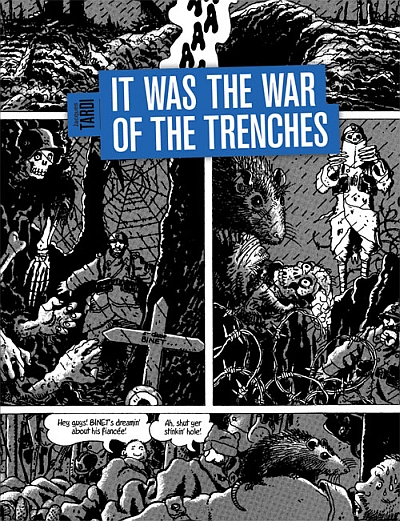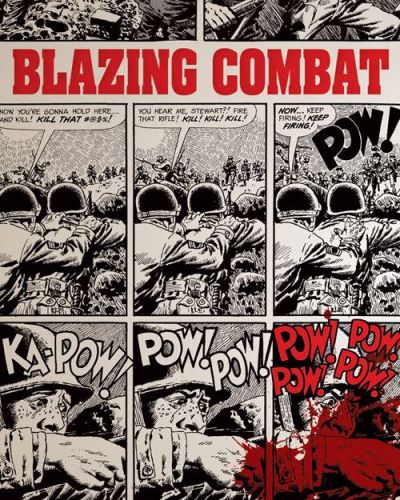Blazing Combat / It Was the War of the Trenches
Reviewed by Peter Campbell 19-Apr-11
What makes a comic an Important comic? Here are two collections that are thematically linked, and which can both be considered to be landmark comics of their type.
What makes a comic an Important comic? Here are two collections that are thematically linked, and which can both be considered to be landmark comics of their type.
Blazing Combat was one of Warren publishing’s forays outside the comfort zone of its profitable horror comics. It only lasted four issues, killed off directly or indirectly by its pervasive antiwar themes.
The precedent here, and the direct inspiration, was EC’s Two-Fisted Tales and Frontline Combat. As with those titles, the stories here cover a variety of eras, from the American Civil War, through to the present day (the Vietnam War) and, in one instance, possibly even the future. The similarity doesn’t end there. Many of the EC artists make a reappearance: John Severin; Wally Wood; Alex Toth; Reed Crandall; along with a few contemporary names: Gray Morrow; Gene Colan. At the very least, this is always interesting to look at.
The actual scripts are more problematic. Virtually all written by Archie Goodwin, these too share a similarity with the EC comics. They’re tightly structured, considering war from a variety of angles and nationalities, but they’re also often unsubtly moralising. There’s only so many times that you can state War Is Hell before you tire of the formula, no matter how well crafted, no matter how many variations there are on the theme. Goodwin’s writing style has a bombastic tone too, one that stayed with him throughout his writing career, and although this style was in common usage at the time, it doesn’t read well today.
It’s the artists that really make this worth reading. Not all the work is great; some is mediocre. When it’s good though, it’s really, really good. Of particular note are two stories by Alex Toth, ‘The Edge’ and ‘Survival’. The former reduces aerial combat to the barest of marks on paper, and makes the result look graphically thrilling. The latter is a post-apocalyptic story that accentuates the blacks, and which culminates artistically in a killing that is as perfect a piece of panel composition as you’re every likely to see on a comics page.
Toth doesn’t steal all the limelight. It a surprise to see how well Gene Colan’s work holds up, for example, amongst what is a pretty heavyweight collection of artists.
So is it an Important Comic? Yes: because even with its flaws, it voiced a viewpoint that was suppressed in the mainstream media at the time, and which has come to be seen as the dominant viewpoint today. And it’s stunning to look at on occasion too.
 It Was the War of the Trenches was inspired by Jacques Tardi’s grandfather’s recollections of the First World War. For all its atrocities, the First World War is less well explored than other eras. Perhaps it’s just difficult to make an engrossing read out of people stuck in ruts in the ground. Yet engrossing is exactly what this comic is. It’s a collection of loosely linked vignettes, focussing (mostly) on the lives of the French soldiers who lived and, inevitably, died in the trenches. This too expresses the notion that Was Is Hell, but it does so more subtly and with greater force than the stories in Blazing Combat.
It Was the War of the Trenches was inspired by Jacques Tardi’s grandfather’s recollections of the First World War. For all its atrocities, the First World War is less well explored than other eras. Perhaps it’s just difficult to make an engrossing read out of people stuck in ruts in the ground. Yet engrossing is exactly what this comic is. It’s a collection of loosely linked vignettes, focussing (mostly) on the lives of the French soldiers who lived and, inevitably, died in the trenches. This too expresses the notion that Was Is Hell, but it does so more subtly and with greater force than the stories in Blazing Combat.
Tardi’s trick is to focus on the soldiers, and the cumulative and sometimes almost incidental suffering they endure. These aren’t always likeable people. Sometimes they’re misanthropic, self-centred, greedy. Yet Tardi always shows understanding and compassion for his characters. There’s a black streak of humour throughout, too. Tardi mentions that one of his favourite writers is Louis-Ferdinand Celine, and you can see the influence here. Yes, it’s horrific, but it can also be seen to be grotesquely funny.
And the horrors shown are horrors indeed. These aren’t simply ruts in the ground in which the soldiers shelter. They’re rat and lice infested, strewn with remnants of corpses, and the soldiers live their lives in an omnipresent sludge that saps their morale and their energy. Worse than that though are the images they carry in their head, whether of people they have left behind, or of fallen comrades, or of deeds they have committed.
This is illustrated throughout in a style that employs a slightly more naturalistic look than is normally associated with Tardi’s work, yet the trademarks remain. There are no grand gestures: everything is clipped and precise, and he captures both physical action and emotion with equal accuracy. His facial expressions and page compositions are often magnificent, and even small moments carry an emotional intensity.
Criticisms? I have none. Nada. Not a thing. This is a perfect a comic as you could imagine, and it’s deservedly considered a classic, not just of war comics, but of comics as a whole. It’s Important in a different way to Blazing Combat because it hits an artistic and emotional intensity seldom seem in the comics medium, and I urge to you go and buy it, this very instant.
Tags: Alex Toth, Blazing Combat, Gene Colan, Jacques Tardi, War